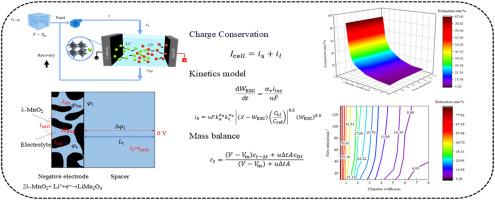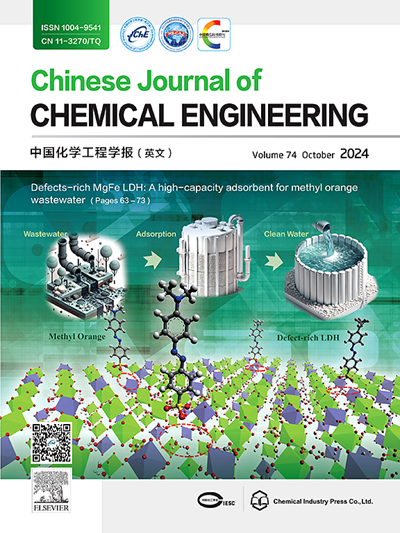Enhanced fluid-flow-field and electric-field synergistic interaction mechanism for lithium-ion separation in dilute solutions: A numerical analysis of electrochemically switched ion exchange system
IF 3.7
3区 工程技术
Q2 ENGINEERING, CHEMICAL
引用次数: 0
Abstract
Electrochemically switched ion exchange (ESIX) is an effective technology for extracting high-value-added ions from dilute solutions. This study focuses on Li+ extraction by employing a comprehensive model to analyze interaction between fluidic dynamics, electric field and ion transport. The model combines Butler–Volmer equation modified by electroactive site concentration, Nernst–Planck equation and Navier–Stokes equation. It is found that the chamber width affects solution phase resistance, thereby altering the potential distribution and influencing the current distribution within the membrane. A narrow chamber increases current density in the solid phase of the membrane, enhancing Li+ extraction. The solution flow-field not only enhances convective transport but also increases the current density in the solid phase, promoting Li+ extraction. There is a synergistic effect between fluid-flow-field and electric-field for ion separation, which is only significant when the chamber width is greater than 2 mm. The synergistic mechanism differs from that in the capacitive deionization system. Therefore, the performance decline caused by a wide chamber can be compensated for by increasing the fluid-flow rate, utilizing the synergistic effect between the fluid-flow-field and electric-field to optimize the lithium extraction efficiency in the ESIX system.

稀溶液中锂离子分离的增强流-流场和电场协同作用机制:电化学开关离子交换体系的数值分析
电化学开关离子交换(ESIX)是从稀溶液中提取高附加值离子的有效技术。本研究以Li+萃取为重点,采用综合模型分析流体动力学、电场与离子输运之间的相互作用。该模型结合了经电活性位点浓度修正的Butler-Volmer方程、Nernst-Planck方程和Navier-Stokes方程。研究发现,腔室宽度会影响固相电阻,从而改变膜内电位分布,影响膜内电流分布。狭窄的腔室增加了膜固相中的电流密度,增强了Li+的提取。溶液流场不仅增强了对流输运,还增加了固相中的电流密度,促进了Li+的萃取。在离子分离过程中,液流场与电场存在协同作用,但只有当腔室宽度大于2 mm时才显著。协同机制不同于电容去离子系统。因此,可以通过增大流体流量来弥补宽腔室带来的性能下降,利用流体流场和电场的协同效应来优化ESIX系统的锂提取效率。
本文章由计算机程序翻译,如有差异,请以英文原文为准。
求助全文
约1分钟内获得全文
求助全文
来源期刊

Chinese Journal of Chemical Engineering
工程技术-工程:化工
CiteScore
6.60
自引率
5.30%
发文量
4309
审稿时长
31 days
期刊介绍:
The Chinese Journal of Chemical Engineering (Monthly, started in 1982) is the official journal of the Chemical Industry and Engineering Society of China and published by the Chemical Industry Press Co. Ltd. The aim of the journal is to develop the international exchange of scientific and technical information in the field of chemical engineering. It publishes original research papers that cover the major advancements and achievements in chemical engineering in China as well as some articles from overseas contributors.
The topics of journal include chemical engineering, chemical technology, biochemical engineering, energy and environmental engineering and other relevant fields. Papers are published on the basis of their relevance to theoretical research, practical application or potential uses in the industry as Research Papers, Communications, Reviews and Perspectives. Prominent domestic and overseas chemical experts and scholars have been invited to form an International Advisory Board and the Editorial Committee. It enjoys recognition among Chinese academia and industry as a reliable source of information of what is going on in chemical engineering research, both domestic and abroad.
 求助内容:
求助内容: 应助结果提醒方式:
应助结果提醒方式:


